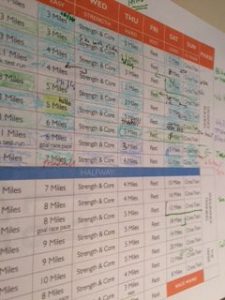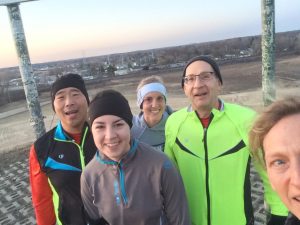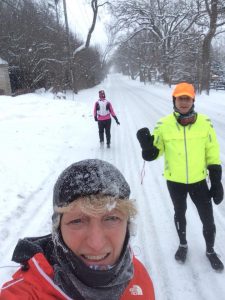I have reached the halfway point in an audacious adventure, in which I train for my first marathon. The training program is 18 weeks long, and I just finished week nine.
I have a training schedule posted on my wall: a calendar for the weeks leading to race day, prescribing how far to run each day to slowly increase my endurance and strength.
How do you run a marathon? By training. How do you train? One day at a time. How do you achieve any huge goal? By training, one day at a time.
Each day, when I complete each workout or run, I color in that day’s box on the schedule. I add a few notes: “hills” or the dreaded “treadmill.” In order to run a marathon in the spring, one must train in the season before spring—namely, winter. We’re training outdoors in winter in Chicago—subzero temps are sometimes part of the adventure. But filling in those boxes feels oddly satisfying.
The adventure started when my running buddy Maryam started talking about running Big Sur Marathon to commemorate her 40th birthday. “Run it with me!” she suggested, never mind that I am a decade and a half older than her. We’ve run several half marathons together, and a 15-mile trail race three years in a row. We’re not fast, but we finish. As Maryam brags, “I’m a completer, not a competer.”
So I said yes to running Big Sur—as did a half dozen or so of our running pals. A group of us will fly to San Jose at the end of April and run up and down a lot of hills, along 26.2 miles of California coastline.
Another running buddy asked me why I chose one of the more challenging marathons in the United States for my first one. I figured if I’m going to run 26.2 miles, I might as well have some pretty scenery to look at (the route goes up U.S. 1 from Big Sur to Carmel along the ocean).
But mostly I am running this marathon because of friendship. One of the best things about running, for me, is the camaraderie of running friends. Our Big Sur group texts stuff about running, plans meet ups for long runs, offers advice on aches and pains and blisters. After our runs, we sit around a local coffee shop, stinking up the place, sipping coffee, chomping donuts, and discussing the merits of various running shoes and nutrition gels. This morning, I met pals to run hills as the sun came up–there’s an interesting bond that connects you when you run together.
I’m also running it because I needed a challenge. I don’t know about you but sometimes I wonder: am I making progress? Am I doing enough? And coloring in those boxes on my training chart has given me evidence, so to speak, that I am not stagnating. I’m moving toward a goal, getting stronger.
Running has changed my mental and physical health. It’s changed my attitude and my actions. It has turned me into a runner—a person who goes to bed early to get up for a 6 a.m. hill workout, and considers a 7-mile run a “medium” distance.
Here are some things I am learning:
- almost anything is easier and more fun if you do it with friends
- achieving difficult goals is much more doable with a plan, and a team
- training is not easy, but it makes almost anything achievable
- when you do hard things, life’s other challenges don’t seem so bad
- achieving running goals helps you achieve other goals
That chart on my wall, which provides a weekly schedule of runs and workouts, has provided a model for reaching other goals. It’s been created by experts, people who know what needs to be done to prepare a person for running a marathon, to help folks like me, who have never done it before. They know: you need speed work. You need rest days. You need long runs, slowly building over time. You run, even when it’s cold or snowy outside.
In a way, I do the same thing with my work. I’ve published dozens of books and studies, articles and blog posts. So I know how to take a book from idea to publication.
In my business, A Powerful Story, I help people achieve their goal of creating published resources: study guides, books, even website copy. I take them through the steps, one at a time. Together, we take their huge goal of publishing a book or study guide. We break it down into smaller, more manageable steps. It’s incredibly gratifying to help my clients see their dreams of publishing a book become a reality.
What are your goals? Have you got a big, crazy, audacious goal? What are the small steps that will get you there?
Interested in a conversation about your goals? Contact me or leave a comment below!




How appropriate that I read this over breakfast after running 6.2 miles with Liz this morning.
Good job, Tim (and Liz)!
For 5 years now, I’ve been running almost every morning and I have joined 15 full marathons. My fastest was at 5 hours and 26 minutes. I’m pretty sure that what you had shared here can improve my P.R.
Thank you so much!